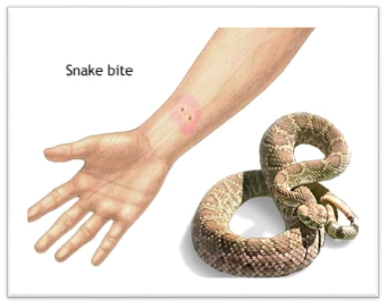Snake bites are common all over the world but the types of snakes are different from country to country.
Symptoms and complications following snake bites are related to bite wound and envenomation by different toxins present in snake venom.
There are poisonous (venomous) and non poisonous (non- venomous) snakes. Majority of encountered snakes are non-venomous. Venomous snakes are then categorized in to mild, moderate to highly venomous types. Specie wise venomous snakes are categorized broadly into elapids (e.g. Cobras, kraits, mambas, sea snakes etc.) and viperids (e.g. Vipers, rattlesnakes, bushmasters etc.) according to their morphology. Their venoms possess different properties and give different clinical pictures upon envenomation. For an example elapid venom mainly target nervous system while viperid venom causes hematological disturbances.
Some of the most venomous snakes are – Russell’s viper, Black mamba, Puff adder, Forest cobra, Tiger snake, Desert horned viper, Common krait, Boomslang, Tiger rattlesnake, Eastern brown snake, Taipan and Sea snakes.
Outcome of the snake bite depends on
- Type of the snake
- Age of the victim
- Amount of venom injected
- Area of the body bitten by the snake
- Co-morbid conditions of the patient
- First aid management
- Medical facilities of the area
Signs and symptoms
There are non-specific clinical features as well as specific clinical features.
Nonspecific features are nausea, vomiting, malaise, abdominal pain, weakness, drowsiness, prostration, syncope.
Signs of local envenomation are local pain and swelling, bleeding and bruising, lymphangitis, regional lymphadenopathy, inflammation, blistering, local sepsis and necrosis of skin and tissue.
Signs of systemic envenomation are differ from species to species. Neurological manifestations are facial muscle weakness, difficulty in swallowing, drowsiness, respiratory paralysis and ptosis (drooping of upper eye lid).
Hematological manifestations are abnormal bleeding (from nose, gums etc.), purpura, ecchymosis, vomiting of blood, tarry colored stools, bleeding per rectum and gum bleeding.
Management
- First ensure safety (of yours and patient) and prevent further bites.
- Do not give a chance to re-bite or get bitten by snake while trying to capture the snake but remember the snake and its color and size, and be ready to describe its features to the hospital staff which may very useful for the further management. But if the snake is dead already you can safely bring it to the hospital.
- Keep the victim calm and reassure that most of the snakes are non-venomous. Keep him resting with bitten area below the level of heart. Exercise will increase blood flow hence carriage of venom into systemic circulation.
- Call ambulance services.
- Remove any item that can constrict the bitten limb when swelling (e.g. tight cloths, rings, bangles and belts).
- Wash the wound with soap and running water. Then cover it with a clean bandage.
- Do not apply tourniquet or apply ice to the wound.
- Do not cut the wound or do not try to remove the venom by pump or by sucking.
- Do not give anything to eat or drink specially caffeine and alcohol which can speed the absorption of venom and promote the distribution of venom all over the body.
- Do not give medications like painkillers unless instructed by your doctor.
- If facilities are available monitor blood pressure, pulse rate and respiratory rate until the emergency services arrive.
- Write down the time of bite.
How to prevent further bites
- Clean the surroundings, where the snakes can hide.
- Do not play with snakes even though most of them are non- venomous.
- Do not provocate snakes.
- Wear high boots and protective clothing if travelling through grassy areas, paddy fields, jungles and marshlands
